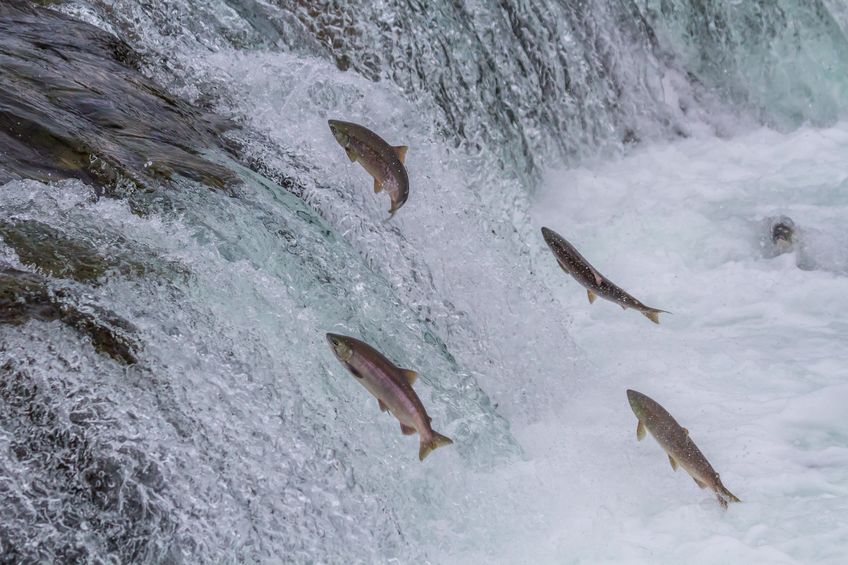Salmon needs no introduction. A sought-after delicacy, it is an excellent source of protein (all 9 essential amino acids), healthy fats including omega-3 fatty acids, and several essential vitamins and minerals.
Salmon is a a first-rated component of healthy and sustainable diets, with the ability to lower the risk of cardiovascular disease, Alzheimer’s, and Dementia.
A species of such high social and ecological significance is now being made available to more and more of the population, thanks to aquaculture.
Salmon: Uniqueness Written All Over it
Salmon is an Anadromous fish i.e., one which migrates from freshwater (where they hatch) to the ocean where they spend most of their lives and grow large before returning to freshwater to spawn.
Among the various species, the most fascinating one is the Pacific Sockeye Salmon. It returns to the west coast of Canada after migrating far out into the pacific, as far west as the Bering sea, where currents from Japan overlap with the Salmon Routes.
Some even go until the coast of Japan. In fact, after the Fukushima nuclear leak incident in Japan, these salmon have even been tested for radiation upon their return.
Importance to Food and Trade
During my research time at the University of British Columbia, I was fortunate to study under a professor who specialized in First Nations’ (Native people group of Canada) fishing history.
The Pacific salmon have been an important food source and trade commodity to the natives of the North Pacific rim for many centuries, including to those of the First Nation community in British Columbia and Washington state.
Today, Salmon continues to remain as a key species of food and trade. The market for wild captured salmon is dominated by the U.S., followed by Russia, Japan and Canada.
Over the past six decades, the US, Russia, Japan, and Canada have accounted for virtually the entire global catch of six species of Pacific salmon: Chinook, Chum, Coho, Masu, Pink and Sockeye salmon.
In the US, the seafood industry is a powerful economic driver, supporting as many as 1.2 million jobs in 2017 and adding $69.2 billion to the GDP. The highest value U.S. commercial species in 2017 was the salmon ($688 million).
Farmed Salmon and Aquaculture
Global production of farmed salmon has also increased consistently. Salmon aquaculture is the fastest growing food production system in the world—accounting for 70% (2.5 million metric tons) of the market.
When it comes to farming, Norway is the largest producer of farmed salmon followed by Chile, Scotland, Canada and Faroe Islands.
In Canada’s British Columbia’s, farmed salmon industry value has increased by 37% between 2014 and 2017, resulting in the creation of over 1,600 jobs.
“The full value chain in the salmon aquaculture sector has turned record high prices over much of the past three years into an unprecedented investment in the sector, including farming infrastructure, process plants, land-based hatcheries, and marine vessels – the net result is an increase in business performance, as well as an increase in environmental and biological performance,” said the Executive Director of the British Columbia Salmon Farmers’ Association.
Two species, Chinook and coho, are increasingly used in marine aquaculture. The net pen production of these species is almost entirely confined to Chile (coho) and New Zealand (Chinook).
Japan is one of the world’s largest consumers of marine products. It is the largest fish-eating nation in the world, consuming 7.5 billion tons of fish a year, or about 10 percent of the world’s catch.
The aquaculture phenomenon is particularly breathtaking in Japan. Japanese are among the world’s most prolific Salmon breeders. Japanese salmon enhancement by hatchery programs began over 120 years ago in Hokkaido and 50 years ago in Honshu.
Japanese domestic Salmon production includes a combination of wild and enhanced stocks of chum, pink, masu, and sockeye salmon, all of which are marketed as wild salmon.
Salmon were among the top imported fish and seafood products in the country in 2019, with the frozen Pacific salmon valued at USD $720.4 million.
For now, the Salmon fisheries is in a good shape. With improvements in aquaculture, the world can be assured of stable Salmon supply for the coming decades, thus ensuring access to a vital source of protein.
